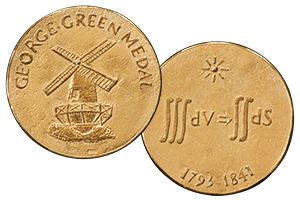 The George Green Medal was established by the University of Mississippi at Oxford, Mississippi, USA, and the Wessex Institute and is supported by Elsevier. It is in honour of the man who single-handedly set up the basis for the modern Boundary Element Method, among other notable achievements.
The George Green Medal was established by the University of Mississippi at Oxford, Mississippi, USA, and the Wessex Institute and is supported by Elsevier. It is in honour of the man who single-handedly set up the basis for the modern Boundary Element Method, among other notable achievements.
The Medal is awarded to those scientists who have carried out original work with practical applications in the field of Boundary Elements and other Mesh Reduction Methods, continuing in this manner to further develop the pioneering ideas of George Green. They are also persons of the highest integrity who, by sharing their knowledge, have helped to establish research groups all around the world. The Medal is given once a year and is presented during the BEM/MRM Conference.
George Green (1793-1841)
George Green was a self-taught genius who mysteriously delivered one of the most influential mathematics and physics works of all time. He educated himself in mathematics and self-published the work “An Essay on the Application of Mathematical Analysis to the Theories of Electricity and Magnetism”. In his very first article, he derived Green’s first, second and third identities, forged the concept of Green’s function, and solved the problem of the electrical potential created by a single charge placed inside a spherical metal shell. The ideas of Green’s function forever changed the landscape of science, as many physics and mathematics problems have been solved using this technique. As Green died early, and his work was discovered only posthumously, it remains a mystery today how Green could produce such a masterpiece without the guidance of a great teacher or school and, in fact, without a formal education. Only recently, due to the advent of powerful computers, has it been possible to take full advantage of Green’s pioneering developments.
Online – 25th May 2022
The George Green Medal 2021 will be presented on the occasion of the 45th International Conference on Boundary Elements and other Mesh Reduction Methods (BEM/MRM 45). The ceremony will take place during a special session on 25th May, followed by a keynote address from the medal recipient.
2022 George Green Medal Recipient
Professor Luiz Carlos Wrobel, Pontifícal Catholic University of Rio de Janeiro, Brazil

Luiz Carlos Wrobel is Full Professor at the Department of Civil and Environmental Engineering at the Pontifícal Catholic University of Rio de Janeiro (PUC-Rio) since 2019. Before that, he was a Professor at the Department of Civil Engineering at COPPE/UFRJ from 1981 to 1989, Professor of the Wessex Institute of Technology in Southampton, UK, from 1989 to 1996, and Full Professor at the Department of Mechanical and Aerospace Engineering at Brunel University London, UK, from 1996 to 2018. He still has a part-time contract with Brunel University London due to ongoing research projects, and is a Visiting Professor at the Tokyo University of Science.
He was a member of the Board of the National Structural Integrity Research Centre, Cambridge, UK, a member of the Board of the Brunel Innovation Centre at TWI, Cambridge, and a member of the Oil & Gas Board of the UK Institute of Materials, Minerals and Mining. He was an external assessor to the University of Leeds, University of Manchester, University of Bradford, University of Central Florida (USA), Nanyang Technological University (Singapore), University Sains Malaysia (Malaysia), University of the Witwatersrand (South Africa), State University of Campinas (Brazil), and the Graz University of Technology (Austria). He is also a member of the Editorial Board of eight international journals.
He has supervised 44 PhD theses, 5 MPhil theses and 40 MSc theses, in Brazil, UK and other
Countries, all successfully defended, in addition to 18 post-doctoral researchers. He was also the supervisor of 67 MEng and BEng final year projects. He is the author or co-author of four books on the Boundary Element Method, one of which was translated into Russian, Japanese and Chinese. He has also contributed 27 chapters to edited books, and has published 198 papers in international journals and 283 papers in international conferences.
He has been awarded the following prizes: The Vehicle Technology Prize of the Institute of Vehicle Engineers, UK, for supervising the Best Final Year Project of 2002; The Best Student Paper Award at the World Congress on Engineering 2017, London, UK, for the paper Kogo, B.E., Wang, B., Wrobel, L.C. and Chizari, M., Residual Stress Simulations of Girth Welding in Subsea Pipelines; and the IX CREA-RJ Prize for Scientific and Technological Projects in Brazil for the supervision of the Best MSc Thesis of 2020/2021.
Keynote Presentation
"Numerical modelling of skin tumor diagnostics through dynamic thermography"
Luiz C. Wrobel - Dept. of Civil and Environmental Engineering, PUC-Rio, Brazil
Jurij Iljaz - Faculty of Mechanical Engineering, University of Maribor, Slovenia
Matjaz Hribersek - Faculty of Mechanical Engineering, University of Maribor, Slovenia
Jure Marn - Faculty of Mechanical Engineering, University of Maribor, Slovenia
Abstract
Dynamic thermography has been clinically proven to be a valuable diagnostic technique for skin tumor detection as well as for other medical applications such as breast cancer diagnostics, diagnostics of vascular diseases, fever screening, dermatological and other applications. Thermography for medical screening can be done in two different ways, observing the temperature response under steady-state conditions (passive or static thermography), and by inducing thermal stresses by cooling or heating the observed tissue and measuring the thermal response during the recovery phase (active or dynamic thermography). Both methods have been used for medical applications; however, recent research on dynamic thermography has shown many advantages over static thermography. The numerical modelling of heat transfer phenomena in biological tissue during dynamic thermography can aid the technique by improving process parameters or by estimating unknown tissue parameters based on measured data. This paper presents a nonlinear numerical model of multilayer skin tissue containing a skin tumor, together with the thermoregulation response of the tissue during the cooling- rewarming processes of dynamic thermography. The model is based on the Pennes bioheat equation and solved numerically by using a subdomain boundary element method which treats the problem as axisymmetric. The paper includes computational tests and numerical results for Clark II and Clark IV tumors, comparing the models using constant and temperature-dependent thermophysical properties, which showed noticeable differences and highlighted the importance of using a local thermoregulation model.
Previous Laureates
Details of the previous George Green Medal presentations can be found in the conference reports listed below:
- 2014 Carlos A Brebbia, UK - BEM/MRM 37 Conference Report
- 2015 Edward Kansa, USA- BEM/MRM 38 Conference Report
- 2016 Alex Cheng, USA - BEM/MRM 39 Conference Report
- 2017 Antonio Tadeu, Portugal - BEM/MRM 40 Conference Report
- 2017 Henry Power, UK - BEM/MRM 40 Conference Report
- 2018 Ney Dumont, Brazil - BEM/MRM 41 Conference Report
- 2019 Zhenhan Yao, China - BEM/MRM 42 Conference Report
- 2020 Ching-Shyang Chen, USA - BEM/MRM 43 Conference Report
- 2021 Dragan Poljak, Croatia - BEM/MRM 44 Conference Report
For further information about the George Green Medal please contact:
George Green Medal
Wessex Institute
Ashurst Lodge, Ashurst
Southampton
SO40 7AA, UK
Tel: +44 (0) 238 029 3223
Email:

 Wessex Institute
Wessex Institute